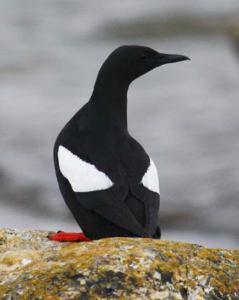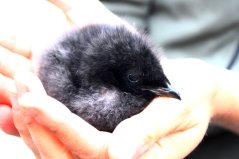
Project
Using technology to benefit bird conservation
Lack of knowledge is one of the factors often limiting effective species conservation. Even in this day and age fundamental knowledge on species demographics and requirements is often not available. However, in the past few decades, rapid advancement and development of (new) technologies allow for non-invasive data collection that can aid species conservation.
Nowadays remotely triggered camera traps are widely used to collect data on a wide range of species. We use, amongst others, camera traps and nestcams to collect data on for instance phenology, diet, reproductive and survival rates, and predation pressure on bird species to benefit their conservation.
One such project targets the black guillemot population in the Baltic Sea. This population is critically endangered, partly because of predation by the invasive and non-native American mink. Previous research shows that climate change is predicted to also negatively affect the black guillemot in future but positively affect the American mink. The combined negative effect of climate change and increased predation may therefore have large consequences for this population. However, environmental change may lead to adaptations in reproductive strategies of species. Such adaptations may mitigate negative effects to some extent
This project was set up to assess the cumulative threats this population is facing as well as collect data on its ecology and adaptive capacity. Modern modelling techniques to obtain information on past, current and future distributions of species combined with fieldwork to monitor the current black guillemot population, and use of camera traps and nestcams to gain more insight in its breeding ecology and predation pressure, is being used to answer questions like: 1) How severe will the impact of climate change be?, 2) Which populations in the Baltic Sea are most at risk?, 3) What are the threats this species is facing?, 4) How flexible is the reproductive capacity of the species?, 5) What can we do to conserve this population? Also see the external project website https://project-black-guillemot.weebly.com
Hof AR, Crombag J, Allen AM. 2018. The ecology of Black Guillemot Cepphus grylle grylle chicks in the Baltic Sea region: insights into their diet, survival, nest predation and moment of fledging. Bird Study. DOI: 10.1080/00063657.2018.1520192
Buchadas ARC, Hof AR. 2017. Future breeding and foraging sites of a southern edge population of the locally endangered black guillemot (Cepphus grylle). Bird Study 64:306-316. DOI: 10.1080/00063657.2017.1358251
Funded by: King Carls XVI Gustaf's 50 year fund for Science, Technology and the Environment, Dobberke Foundation for Comparative Psychology

